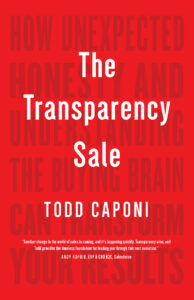Trust
Every year, Gallup publishes a survey listing the most-to-least trusted professions. As you might guess, bringing up the bottom of the list are members of Congress – and car sales people. Todd Caponi, a self-professed nerd for sales methodology, had a revelation that he felt so passionately about that he left his role as a chief revenue officer of a high-flying tech company to write about it.
In his book, The Transparency Sale: How Unexpected Honesty and Understanding the Buying Brain Can Transform Your Results, he outlines how honesty, authenticity and leading with your product’s flaws actually is an evolution coming to the world of sales – which could mean a new perception of the profession.
It’s a book that I thoroughly enjoyed. Service-oriented leaders will celebrate Todd’s approach to honesty and transparency. Not only did I enjoy his philosophy, I was pleased to see a common friend, Jeff Rohrs, was one of the earliest supporters of the book. That grabbed my attention even more.
I asked Todd to discuss how using unexpected honesty and understanding the buying brain will change the profession for the better.
How Sales Has Changed
How has sales changed with the advent of the internet, email marketing, and changing consumer expectations?
Since the beginning of time, buyers have sought answers to their brain’s desire to predict what their experience is going to be when making an unfamiliar purchase. “Will this wheel help me move my stuff more effectively, and is it worth the cost of three chickens?” “Will this sliced bread machine save me enough time to make up for the price I’m paying in terms of dollars and potential lost fingers?” For uncounted years, the primary source of information for a buyer to satisfy their predictive need was provided by the individual and company selling the products themselves.
Beginning with the advent of the Information Age in the mid 1970’s, followed by the Digital Age in the 1990’s, the way sellers provide value to buyers in their quest to predict their experience changed dramatically. Buyers now had other sources to gather information, so their expectations changed – simply because they were now better armed. With the digital age, buyers could now self-diagnose their pains and self-prescribe the solution to those pains without the aid of sellers. The good news is that human beings are not great at self-diagnosis and self-prescription. This is why websites like WebMD did not put doctors out of business, and why the internet has not and will not put sellers out of business either. In each case, it required a professional evolution, and those evolutions are not stopping.
The Importance of Online Reviews
Given your background, you are uniquely qualified to talk about online reviews. Would you share some of the research on their importance?
We’ve entered what I like to call a “non-obvious” era, and that is the Feedback Age. The availability of feedback and reviews on practically anything we interact with is growing at an accelerated pace. 95% of consumers now read reviews before making a purchase of a product they have not purchased before on sites like Amazon.com. Our children, who also happen to be our future buyers, are looking at reviews before downloading apps to their iPad, or even selecting what shows to watch on Netflix. We use reviews to select restaurants, hotels, experiences and even Uber drivers (who also are rating us). We trust the feedback of others we don’t even know more than the companies selling the products themselves.
The pervasiveness of reviews and feedback has now permeated the B2B selling world, where buyers’ ability to predict their experience has become even easier. Companies like G2Crowd and TrustRadius are growing rapidly to provide ratings and reviews for technology purchases, and similar sites are popping up in just about every industry segment. It’s also impacting recruiting, as sites like Glassdoor, where current and former employees and can leave reviews regarding the employers, provide a peek into the culture of an organization before a recruit decides where to point their career.
And here’s the data point that brought me to the realization that my passion profession, sales, was once-again evolving: 82% of consumers specifically seek out negative reviews before making a purchase, where consumers are more likely to purchase a product with an average review star rating in the 4.2 – 4.5 range than one with a perfect 5.0.
Your products are not perfect. In this Feedback Age, we can no longer hide our product’s flaws and expect to sell effectively. It’s time to embrace this idea that transparency sells better than perfection.
The Power of Transparency
“Transparency sells better than perfection” is an idea that I fully endorse and have seen first-hand for many years. Talk about the power of transparency.
Amazon.com started this trend in the 1990’s by providing both positive and negative reviews right alongside the products they were selling on their website, and they’ve done pretty well, right? Let’s think about the data points we just discussed, where a 4.2-4.5 sells better than a 5.0, and how we’re all wired to attempt to predict what our experience is going to be like when purchasing an unfamiliar product. When a website is acting as the sales person, transparency sells. A buyer is provided with all of the information they need to make a purchase, which they do quickly and with confidence when both positive and negative aspects of that purchase are readily available. What would happen if we brought that to the B2B (business-to-business) world?
As the Chief Revenue Officer of a fast-growing Chicago technology company, I began to experiment with leading with our flaws and embracing transparency. The results were amazing. Our sales cycles shrank dramatically. In one case, what would have normally been a six-month cycle shrank to under six weeks. Our win rates went up, not only because we were working on better qualified deals, but we were better able to qualify out the deals we would likely eventually lose anyway. As the old saying goes, “If you’re going to lose, it’s better to lose fast.” And, we made it really difficult for our competitors to position against us – our flaws were coming from us instead of them. Trust was the foundation, and we maintained control of the dialogue and the process. It was incredibly powerful!
How Decisions Are Made
Would you share a little about how decisions are made and how the transparent approach best works because of this?
This is such a timely and interesting question, given that neuroscientists have recently pinpointed how our brains make decisions. Knowing how the brain makes a decision would be amazingly valuable to sales professionals, right? Yet, most of that understanding has yet to make its way into the sales training and enablement world.
I’m not a neuroscientist myself, but I did quite a bit of research on it for the book. One interesting aspect in my research is the revelations regarding how our brains are wired to resist influence. We make decisions in our midbrain, which governs feelings and emotions. Our logic center is used to justify those feeling decisions. As neuroscientist Antonio Damasio surmised, “We are not thinking machines that feel. We are feeling machines that think.”
When we feel like we’re being unduly influenced, we filter that language, using it to solidify our previously held feelings. In selling situations, when a seller is presenting their solutions as being perfect, our minds and brains know better. As a result, our level of trust in the seller is reduced, which causes us to do more homework outside of the claims of that seller. As a result, decision cycles are slowed, and risk in the process is heightened.
When using transparency, we disarm the buyer’s midbrain filter. The buyer is more apt to fully engage when both positives and negatives are presented along with the product’s traits. The buyer subconsciously feels less of a need to do additional research and feels more certainty in their prediction of their experience, which speeds decision making.
In the end, leading with our flaws allows for decision making optimization. When done correctly, our overall messages will instantly have more credibility and resonate more effectively.
What are some of the most common errors sales professionals make during presentations?
There are really two things that I, as a sales leader, have been guilty of doing myself.
As a sales leader, I’ve been guilty of teaching my sellers how to focus on making “logical” arguments (ROI, data, features and benefits, etc.) as to why our solution was ideal for the buyer’s situation. Given that we make decisions based on feelings, and only use logic to justify our decision, we are subconsciously polarizing an audience when we make logical arguments. Given that many of our selling efforts require “consensus,” where multiple individuals are involved in a decision, it’s vitally important to use decision science to bring a group together. For example, think about the last political debate you listened to. Our beliefs, experiences and upbringing create our perceptions of the logic we hear – so any logical argument which aligns with our previously held beliefs solidifies them. Any logical argument against our beliefs causes our brains to create counter-arguments, thus also solidifying our previously held beliefs. Logic is a no-win. If a buyer listens to your logic with a previously held bias towards your competitor, you run the risk of further solidifying that bias. On the other hand, when we tell stories injecting feelings and emotion, audiences are brought together in their thinking.
With that, the second error is in our presentation choreographies. Most sales presentations are mistakenly focused on how great our offering is for the buyer – instead of telling a compelling story focused on how great the buyer can be. Through a simple reordering of a presentation to a story-based choreography, sellers can begin with the buyer’s current state (setting), discuss why that current state is not sustainable (conflict), and end with the potential future state (resolution). Injecting some humility into the choreography disarms, and the story-based choreography engages which also compels a group to a faster consensus.
Remember, logic is polarizing, while emotion is binding. Make the audience the star of your story-based presentation.
What has been the reaction to your book so far?
So many sellers that I’ve spoken with have told me how they embrace honesty, authenticity and transparency when they sell, but have felt as though there’s a trade-off. By being honest, they often feel as though they’re risking the sale. The data, science and practical applications are now showing those sellers that the opposite is actually true. Embracing decision science and unexpected honestly actually maximizes your results, and so many readers have found validation through the book.
Ironically, the feedback on booksellers’ websites have been fantastic, to the point where the book’s review score on Amazon is a 4.82 – but I’m fine with that. Artificially inflating a review score is bad, but so is artificially deflating it…and I love the perfect 5 scores!
For more information, see The Transparency Sale: How Unexpected Honesty and Understanding the Buying Brain Can Transform Your Results.


